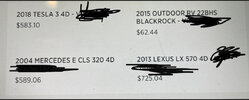Much of this is wear and tear. Cracked rims, tires, windshield glass, windshield wipers? Why are you doing these things at Tesla?There are lots of things to service in Tesla's.
here is a short list of the things on the 3 S's we have owned:
Door handles (X8) - 6 of 8 covered by Telsa
Air shock (X2) - not covered by Tesla
MCU's (X2) - not covered by Tesla
Air suspension sensors (X1)
Adjustable rear camber links (cause Tesla was too cheap to design them in), eating rear tires like a teenager eats donuts (fixed)
12 Volt battery (X4)
HEPA Filter (X2)
Tires (X40) over 200K on 3 cars, so about every 20K
Front Windshield glass (X2)
Windshield sprayer (X1)
Windshield wipers (X10)
Brake Fluid (cant remember how many ounces)
Headlight (2016), (X4) - the damn eyebrow LED is blown again.. out of warranty now.. so add another headlight assembly
Trim issues (about 18 trips)
Leather issues (Tesla told me to go F myself)
Drive Unit (replaced before they figured out a wire was loose and causing the short code) (X1)
Half Shafts (X3), starting clicking again after 5K (out of warranty now)
lower front aft control arm catastrophic failure (X2) - not covered by Tesla
Steering bracket bolts seared off, fixed under recall warranty
21 inch wheels (X3) - cracked
19 inch wheels (X1) - cracked
Towed (flatbed) to dealer 3 times (or about once per vehicle during its life)
Other than that they are maintenance "free" with about $20k freed from my wallet with a large portion of that being the MCU's, that Tesla failed to cover.
Air suspension and large rims just suck. I hate it that both have become sort of an consumer demand/industry standard. For performance A car the size of a S shouldn’t have any larger then a 17-18” rim. Air suspension also is an unnecessary complexity, hydraulic and springs are better and more reliable. Tesla uses the bosch system MB, jeep, Ram uses.
I canceled my Rivian order since it has air springs and the smaller rims you can put on are 20”. I’m concerned the CT will have the same issue. Trucks shouldn’t ever have over an 18” rim, and air suspension sucks.



